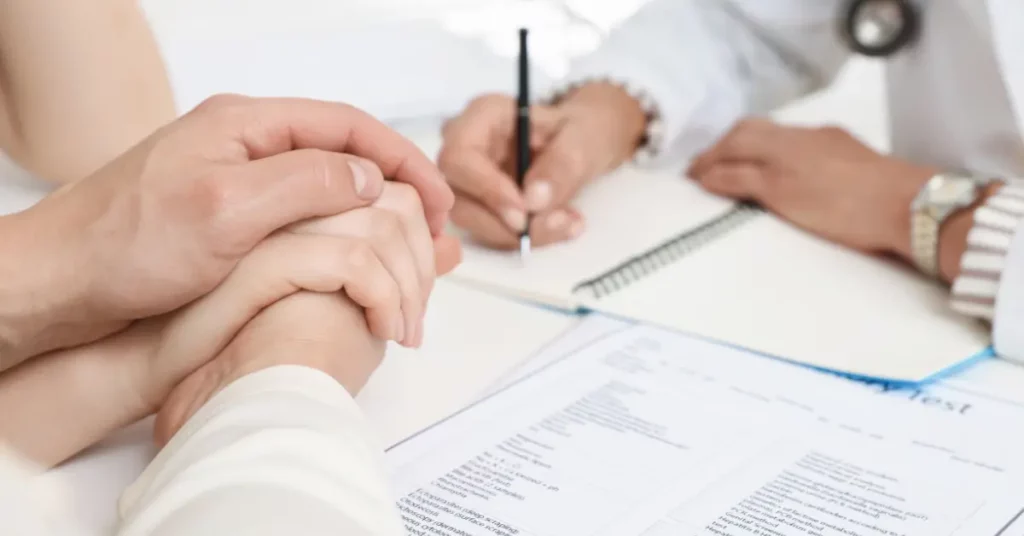For many people, understanding age-related fertility decline is crucial when planning a family. We often hear references to a “ticking clock,” alluding to the concept of biological clock fertility decline. The idea that as one ages, one’s natural ability to conceive starts to decrease. The connection between fertility and age in women is a well-documented reality. Women’s fertility peaks in the late teens to 20s and then gradually wanes over subsequent decades, making it increasingly difficult to conceive as years go by. This is a regular part of reproductive health and aging, but one that can significantly impact life decisions in our modern world.

Why Does Fertility Decline with Age?
Fertility naturally declines with age due to biological changes in the reproductive system. In women, the primary reason is that they are born with a finite supply of eggs (oocytes), and this supply decreases over time. Unlike men, who continuously produce new sperm throughout their lifespan, females do not generate new eggs. A baby girl is born with perhaps 1–2 million immature eggs in her ovaries, but this number drops to about 300,000–500,000 by puberty and continues falling as she ages. By the time a woman reaches her mid-30s, her ovarian reserve is much lower than in her youth. This steady depletion of egg supply is a fundamental aspect of female ovarian reserve and age.
It’s not just the number of eggs that matters. Egg quality also declines with age. Each egg carries the genetic material that will be contributed to an embryo, and as eggs get older, they accumulate more DNA damage and have a higher likelihood of chromosomal abnormalities. This age and egg quality decline means that even if an older woman ovulates an egg, that egg may be less capable of making a healthy, viable embryo. In younger women, a high proportion of eggs are genetically normal; in older women, a greater proportion of eggs may have chromosome issues, which can lead to difficulties conceiving or a higher risk of miscarriage. The reproductive aging in women involves both a decline in egg quantity and quality over time. Hormonal changes accompany this process: as the egg supply dwindles and quality declines, the ovaries become less responsive, and levels of hormones such as follicle-stimulating hormone (FSH) and anti-Müllerian hormone (AMH) shift, reflecting a decrease in fertility potential.
Men, on the other hand, are not born with a set number of sperm. Instead, men produce new sperm continually throughout their lives. This means men don’t “run out” of sperm the way women do with eggs. However, this does not imply that male fertility remains constant forever. There is still an age-related impact on fertility for men, although it usually emerges later and more gradually. Over time, a man’s sperm production can slow, and the quality of sperm can deteriorate. DNA fragmentation in sperm tends to increase as men age, and older men might have lower sperm counts, reduced sperm motility (movement), or a higher fraction of abnormal sperm. Also, testosterone levels slowly decline with age in many men, which can indirectly affect fertility. So, while men can remain fertile into their 40s, 50s, and beyond, the efficiency of their reproductive system does decline to some extent. The bottom line is that human fertility is optimized for youth: as we get older, biological changes make it progressively harder to conceive a healthy pregnancy. In the following sections, we will detail fertility changes by age and pinpoint when noticeable declines begin for women and men.
Fertility Decline Timeline in Women: 20s, 30s, 40s
At what point should prospective parents know when fertility decline starts? For women, fertility doesn’t drop off suddenly at a single age but rather undergoes a gradual downward slope that steepens over time. Let’s break down the fertility decline timeline for women by age ranges:
- In Your 20s: The late teens through mid-20s are often considered a woman’s most fertile years. During this period, the chances of conception per cycle are at their peak. A healthy woman in her early 20s might have roughly a 25% chance of getting pregnant in any given menstrual cycle. Egg quantity is abundant, and egg quality is generally high, resulting in a strong ability to conceive. In the late 20s, there may be a very subtle decline in fertility, but for most women, it’s not very pronounced yet.
- In your 30s: Fertility begins to decline gradually in the early 30s. Many women in their early 30s are still quite fertile. Chances of conception remain fairly good, though a bit lower than in their 20s. However, fertility decline after 30 is a real phenomenon, albeit initially a gentle slope. As a woman moves from her early to mid-30s, the decline becomes more noticeable. By the mid-30s, both egg quantity and quality are diminishing at a faster rate. This is why 35 is often considered a turning point; in fact, 35 is sometimes termed “advanced maternal age” in medicine, indicating the point at which certain fertility and pregnancy risks become more significant. It’s not that fertility falls off a cliff on a woman’s 35th birthday – far from it. But statistically, fertility decline after 35 tends to accelerate. Female fecundity decreases gradually but significantly starting around age 32, and then declines more rapidly after age 37. A woman at 35 has a lower chance of conceiving per month than she did at 30, and by 37, the drop is steeper. This is why some couples in their late 30s may find it takes longer to get pregnant, even if they have no obvious health issues. The later 30s mark a critical period in the age and conception chances for women.
- In Your 40s: Once a woman enters her 40s, fertility has usually declined substantially. The ovarian reserve is very low at this time, and those eggs are aging. The ability to conceive naturally in the early 40s is markedly reduced compared to the 20s or 30s. Many women in their early 40s still ovulate and can get pregnant, but the odds per cycle are quite low. By age 40, for example, a woman’s chance of getting pregnant naturally in a given cycle is on the order of only a few percent. The 40s represent the tail end of the reproductive window, and by age 45 and beyond, natural pregnancy is exceedingly rare for women. Menopause typically occurs around age 50–51, and a few years before that, fertility is effectively near zero.
It’s essential to note that these age ranges represent averages and general trends. Every individual is different. Some women in their late 30s may still be quite fertile, while others in their early 30s might experience unexpected difficulties. Genetics, health conditions, and lifestyle factors play a role in how quickly fertility declines for a given person.
Male Fertility and Age: A Gradual Decline
Men do experience male fertility and age decline, but the pattern is more gradual compared to women. Men in their 20s and 30s generally maintain high fertility, with only slight changes in sperm parameters as they age through these decades. It is often said that there is no strict “male menopause” equivalent to women’s menopause. Men can potentially father children well into their 50s, 60s, or even older. However, this doesn’t mean male fertility is ageless. Around the age of 40 or so, men’s fertility does start to decline measurably in many cases. Sperm quantity and quality peak in a man’s late 20s to early 30s and can slowly decline thereafter.
It can take longer for older men to achieve a pregnancy, even if their partner is young. Conception is about 30% less likely for men over 40 compared to men under 30. This means that a couple might face more difficulty getting pregnant when the father is older, even if the mother is still relatively young. There are a few biological reasons behind this male age-related fertility decline. As men age, the number of healthy sperm and their motility tend to decrease. An older man’s testes may produce fewer sperm, and the sperm produced may not swim as well or may have more DNA damage. Second, the semen volume can decrease with age, which may slightly reduce the number of sperm delivered. Moreover, men in their 40s and beyond are more likely to have accumulated health issues that might indirectly affect fertility.
It’s also worth noting that advanced paternal age can carry some risks for offspring. While women’s age primarily affects whether they can conceive and carry a pregnancy, men’s age is linked to a gradual rise in the risk of new genetic mutations in sperm. This has been associated in some studies with a slightly higher incidence of certain conditions in children of older fathers. Still, the focus here is on the ability to conceive, and clearly, fertility decline in men and women differs in timing. Men’s fertility decline typically becomes significant about a decade or more later than women’s. Many men remain reasonably fertile into their 40s and even 50s. By the time a man reaches his mid-40s or 50s, the chances of conception are lower than in his younger years.

Risks of Age-Related Fertility Decline
Beyond simply making it harder to get pregnant, age-related infertility risks include a higher likelihood of various complications and challenges once conception is achieved. Being informed about these factors can empower individuals to make well-considered decisions regarding family planning and seek appropriate medical guidance:
- Elevated Miscarriage Rates: As women advance in age, specifically beyond their mid-30s, the probability of experiencing a miscarriage significantly increases. This heightened risk is primarily due to a decline in egg quality, leading to a greater number of embryos with chromosomal abnormalities. These genetic irregularities often prevent a healthy pregnancy from progressing, resulting in loss.
- Increased Risk of Infertility: Beyond the challenges of a successful pregnancy, advanced age directly correlates with a higher likelihood of infertility itself. Women over 35 face a decreased chance of natural conception and are more prone to conditions like endometriosis or fibroids, which impede fertility. While egg quality remains the dominant factor, even the uterus can exhibit subtle age-related changes. Aging contributes to infertility through reduced sperm count or function, compounded by environmental exposures over time.
- Maternal Health Complications: For mothers conceiving at an advanced age, there is a notable increase in various pregnancy complications. These include a higher incidence of gestational diabetes, a condition characterized by high blood sugar levels during pregnancy, and elevated blood pressure. Additionally, older mothers may face a greater necessity for medical interventions during delivery, such as C-sections, due to potential labor complications or pre-existing health conditions.
- Chromosomal Abnormalities in Offspring: One of the most significant concerns associated with advanced parental age is the elevated risk of chromosomal abnormalities in the baby. Conditions like Down syndrome, caused by an extra copy of chromosome 21, become more prevalent as maternal age increases. This dramatic rise is directly linked to the decline in egg quality, as older eggs are more susceptible to improper chromosome division during cell replication.
- Compounded Effects of Lifestyle and Environment: The impact of age on fertility and pregnancy is not solely biological but also influenced by cumulative lifestyle and environmental factors. Longer exposure to toxins, such as years of smoking, can significantly damage both sperm and eggs, exacerbating the natural decline associated with aging. These external elements combine with intrinsic biological changes to further reduce fertility prospects and increase pregnancy risks over time.
Being aware of these reproductive aging issues in women and the analogous issues in men can help people make informed choices.
Options for Preserving Fertility and Overcoming Age Challenges
While we cannot stop the biological clock, there are ways to work with it. For those who are not ready to have children yet but want to keep the possibility open, various fertility preservation options exist. Age is the most critical factor in the success of these options. The earlier you take action, the better the outcomes tend to be. For women, the most common fertility preservation method is egg freezing. The idea is to harvest and freeze eggs at a younger age, when they are more plentiful and healthier, and store them for future use. If a woman freezes her eggs at, say, 30 years old, and then tries to use them to get pregnant at 40, those frozen 30-year-old eggs have a much higher chance of producing a baby than her natural 40-year-old eggs at that time.
Another option, if circumstances allow, is embryo freezing. This is similar to egg freezing, but the eggs are fertilized with sperm in the lab to create embryos, which are then frozen. Embryo freezing is often used by couples who know they want children together but need to delay the pregnancy; it can also be a good option if you have a partner or are using donor sperm and want to maximize the chance of future pregnancy. Both egg and embryo freezing are methods to essentially pause the biological clock for a bit by banking younger genetic material for later use. For men, fertility preservation usually involves sperm banking. Because men produce new sperm continuously, it’s less common for men to freeze sperm for age-related reasons. However, a man who anticipates a delay in childbearing or worries about declining sperm quality could choose to store sperm when he is younger. Sperm freezing is a well-established, relatively simple procedure; frozen sperm can be stored for many years and later used in intrauterine insemination (IUI) or in vitro fertilization (IVF). Fertility clinics can assess ovarian reserve through blood tests and ultrasounds, and they can perform semen analyses for men to check sperm parameters. Depending on the results, doctors might recommend treatments such as IVF, which can help some older women by combining multiple eggs and selecting viable embryos. In cases where a woman’s eggs are no longer viable, one option is to use donor eggs from a younger woman, which can dramatically improve the chance of success. Donor sperm is also an option if male factor age-related infertility is severe, though this is less commonly needed purely for age reasons.

For personalized guidance, it’s wise to consult a medical professional who can assess your individual situation. Fertility experts, such as the team at IVF Center Hawaii, can provide testing, resources, and treatment options tailored to your needs. Understanding fertility decline is about empowering you with knowledge. By appreciating what changes occur and when, you can take control of your reproductive plans and make the decisions that are right for you.
Sources:
- britishfertilitysociety.org.uk British Fertility Society – At what age does fertility begin to decrease? (egg count and quality by age)
- acog.org ACOG Committee Opinion – Female Age-Related Fertility Decline (fertility decline starts ~32, accelerates after 37)
- utswmed.org UT Southwestern Medical Center – How does a father’s age affect fertility? (study: conception 30% less likely if father is over 40)
- my.clevelandclinic.org Cleveland Clinic – Pregnancy after 35 (Advanced Maternal Age) (miscarriage rates ~20% at 35, ~40% at 40, etc.)
